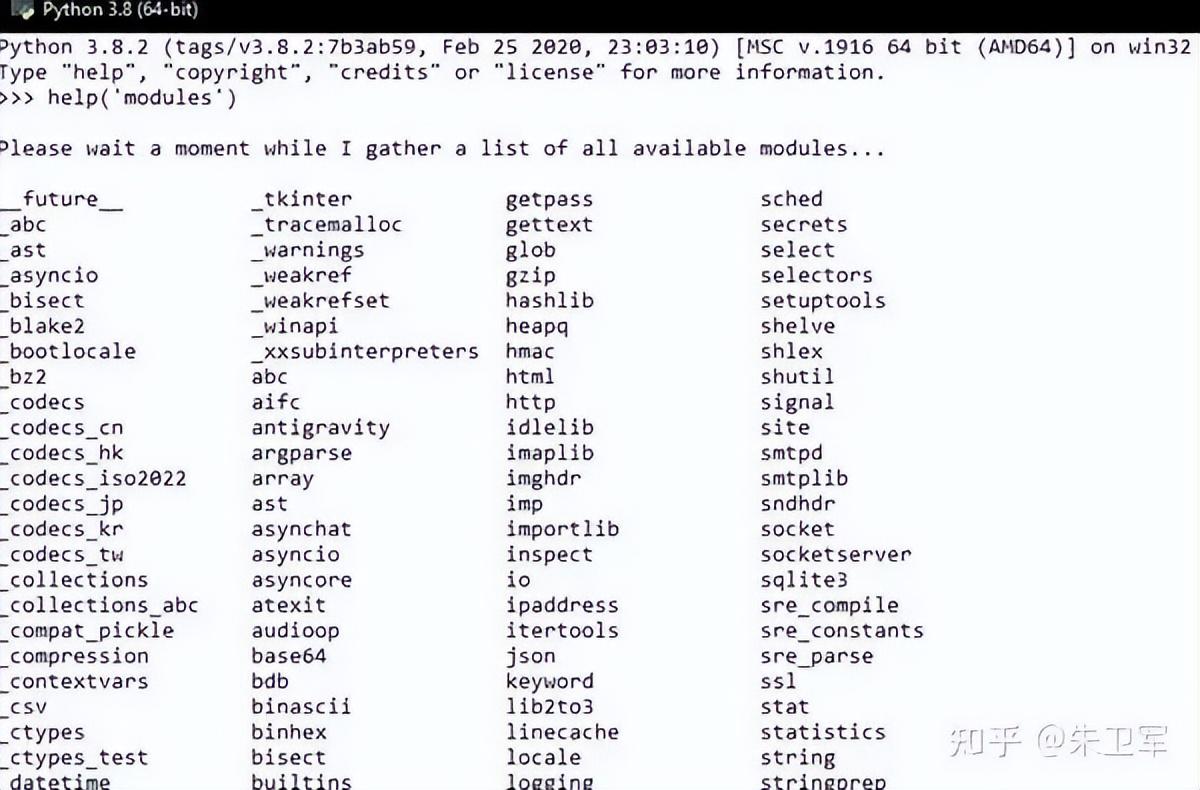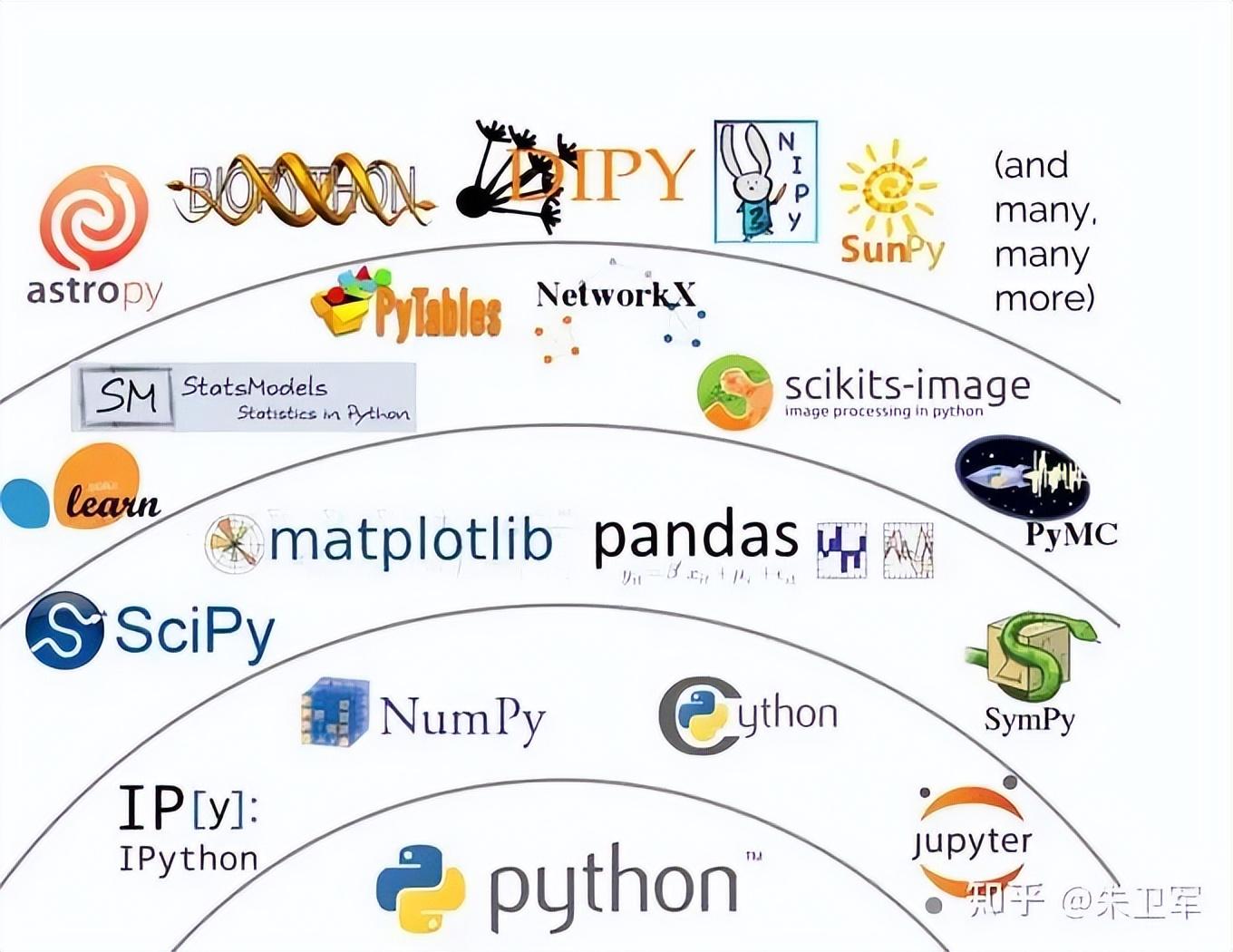Python/ target=_blank class=infotextkey>Python常用的模塊非常多,主要分為內置模塊和第三方模塊兩大類,且不同模塊應用場景不同又可以分為文本類、數據結構類、數學運算類、文件系統類、爬蟲類、網絡通訊類等多個類型。
大家常用的內置模塊比如:math、re、datetime、urllib、os、random等,第三方模塊比如pandas、numpy、requests、matplotlib等。
什么是Python模塊?
模塊是將復雜的、同一應用領域的功能代碼進行封裝,你只需要調用接口,輸入相應參數,便可以輕松拿到結果,類似瑞士軍刀、萬能工具箱。

常用內置模塊,約200多個
內置模塊,顧名思義就是Python軟件內嵌的模塊,無需額外安裝。
想要了解詳細的內置模塊,最好去Python官網看,挺詳細的。
https://docs.python.org/zh-cn/3/library/index.html。
你也可以在代碼行輸入print(help(modules)),會顯示全部的內置模塊。

這里舉幾個常用的內置模塊,并附上代碼:
「math 模塊」
用來進行數學計算,它提供了很多數學方面的專業函數,適合科研、算法。
import math
# 計算平方根
sqrt_value = math.sqrt(25)
print("Square Root:", sqrt_value)
# 計算正弦值
sin_value = math.sin(math.radians(30))
print("Sine Value:", sin_value)
「re 模塊」
正則表達式在Python中的擴展實現,該模塊能支持正則表達式幾乎所有語法,對于文本處理來說必不可少。
import re
# 查找匹配的字符串
pattern = r"d+"
text = "There are 123 Apples and 456 oranges."
matches = re.findall(pattern, text)
print("Matches:", matches)
「datetime 模塊」
用于處理日期和時間,這個模塊非常實用!
import datetime
# 獲取當前日期和時間
current_datetime = datetime.datetime.now()
print("Current Date and Time:", current_datetime)
# 格式化日期時間
formatted_datetime = current_datetime.strftime("%Y-%m-%d %H:%M:%S")
print("Formatted Date and Time:", formatted_datetime)
「urllib 模塊」
用于進行網絡請求,獲取網頁HTML,所謂的爬蟲就是這個模塊。
import urllib.request
# 發起HTTP GET請求
response = urllib.request.urlopen("https://www.example.com")
html = response.read()
print("HTML Content:", html[:100])
「os 模塊」
提供了與操作系統交互的功能,比如文件和目錄操作。
import os
# 獲取當前工作目錄
current_dir = os.getcwd()
print("Current Directory:", current_dir)
# 列出目錄中的文件和子目錄
files_and_dirs = os.listdir(current_dir)
print("Files and Directories:", files_and_dirs)
「random 模塊」
用于生成偽隨機數。
import random
# 生成隨機整數
random_integer = random.randint(1, 10)
print("Random Integer:", random_integer)
# 從列表中隨機選擇元素
random_element = random.choice(["apple", "banana", "cherry"])
print("Random Element:", random_element)
「json 模塊」
專門用來處理 JSON 格式數據。
import json
# 將字典轉換為 JSON 格式的字符串
data = {"name": "Alice", "age": 25}
json_string = json.dumps(data)
print("JSON String:", json_string)
# 將 JSON 格式的字符串轉換為字典
parsed_data = json.loads(json_string)
print("Parsed Data:", parsed_data)
「collections 模塊」
提供了一些除list、dict之外有用的數據容器,比如 defaultdict、Counter 等。
from collections import defaultdict, Counter
# 創建默認字典
word_counts = defaultdict(int)
words = ["apple", "banana", "apple", "cherry", "banana", "apple"]
for word in words:
word_counts[word] += 1
print("Word Counts:", word_counts)
# 統計元素出現的次數
element_counts = Counter(words)
print("Element Counts:", element_counts)
「csv 模塊」
專門用于處理逗號分隔值(CSV)文件。
import re
# 查找匹配的字符串
pattern = r"d+"
text = "There are 123 apples and 456 oranges."
matches = re.findall(pattern, text)
print("Matches:", matches)
「sys 模塊」
提供了與Python解釋器交互的功能,例如訪問命令行參數。
import sys
# 獲取命令行參數
arguments = sys.argv
print("Command-line Arguments:", arguments)
常用的第三方模塊,十幾萬個
Python之所以這么受歡迎,很大一部分原因得益于強大的第三方工具生態,幾乎各個領域都有對應的模塊可以使用。
比如
- 數據科學領域:pandas、numpy、scipy、sympy
- 可視化領域:matplotlib、seaborn、plotly、bokeh、pyecharts
- 機器學習領域:scikit-learn、keras、Tensorflow
- 大數據領域:pyspark、pyflink
- 爬蟲領域:requests、scrapy、bs4
- 金融量化領域:ta-lib、zipline、pyfolio
其他各領域都有相應的模塊可以使用,這里就不一一列舉。

總得來說,Python常用的模塊非常多,還是要根據你的使用場景來選擇,大家可以去Python官網、Github上找相應的模塊及教程。






